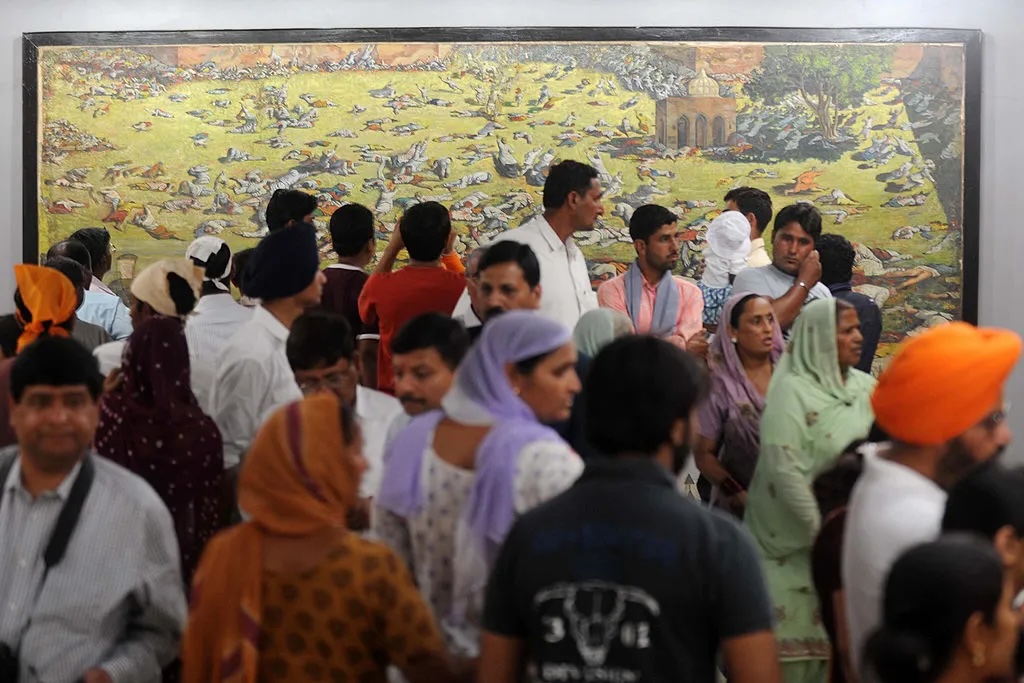
Indian visitors in Amritsar in 2011 look at a painting depicting the Jallianwala Bagh massacre
Photo credit: Narinder Nanu—AFP via Getty Images
Full article at Time Magazine
Author: Dr. Hardeep Dhillon
One hundred and five years ago, in April 1919, Mani Ram, a middle-aged dental surgeon, frantically ran to one of his son's favorite play areas. His son, Madan Mohan, enjoyed playing at Jallianwalla Bagh, an empty plot of land in the center of Amritsar, Punjab, but had not come home. Mani Ram was worried because British officer General Reginald Dyer had just ordered his troops to cordon off Jallianwalla Bagh and open fire on all Indian subjects without warning. His officers fired 1,650 bullets at Indians, killing and injuring hundreds, including children at play.
Mani Ram found his son’s lifeless body, among hundreds of others at Jallianwalla Bagh, and carried it home.
Two years later, Mani Ram filed a claim with the imperial government for compensation for the loss of his son. The colonial government had long provided compensation payments to European families when their property was destroyed, or family members were injured or killed. For example, the British government compensated British Loyalists after the American Revolution, British enslavers after the abolition of slavery, and British subjects in India after a large wave of rebellions in 1857.
But 1921 was likely the first and only large-scale compensation for Indian families under British imperial control. British officials were adamant that the payments did not set a precedent and were eager to make them discreetly, burying the procedure, at times, in misclassified files in the archive. These files across London, Delhi, and Chandigarh show a deep racialized and gendered disparity in the value attributed to Indian and European lives, as well as the care distributed to their surviving family members or maimed subjects making such claims. Today, practices of compensation and reparations are still sorted through similar legal structures that echo those very racial disparities.
Dyer’s instruction to shoot Indians at Jallianwalla Bagh was not the only form of imperial violence Indian subjects experienced in 1919. In the early months of 1919, Indians had assembled to protest draconian British policies such as the Rowlatt Act, which granted British officials emergency powers to detain Indian subjects indefinitely without any opportunity for judicial review. In protest, some Indians resorted to attacking the colonial government's infrastructure, such as railway lines, telegraph wires, and local banks.
British officials responded with great force. They caned, flogged, and detained Indian men and male children without warrant. British officials also declared martial law and opened fire on protesting Indians in Delhi, Bombay, Lahore, Amritsar, Kasur, and Gujrat. British pilots also air bombed parts of Gujranwala.
In the aftermath of the violence, local district magistrates utilized their discretion to allocate ₹523,571 to widows and children of five Europeans who lost their lives in Amritsar and Kasur, as well as to Europeans who were injured, shocked, or attacked during the protests. The compensation funds came from taxes and indemnities leveraged on Indians rather than British funds.
In stark contrast, state officials "distribut[ed] quietly" a sum of ₹14,050 to a handful of Indian subjects "through confidential enquiries," fearing they should offer at least some reprieve for Indian subjects. Imperial officials hoped that this covert distribution of payments would discourage new requests and limit any precedents for compensation for state violence in the future. Most Indian families who suffered death or injury received no compensation. Those few families who did receive payment received low sums, far less than their European counterparts, and had to rebuild their lives with few resources.
The racial disparity in payments reflected the significant difference in the value placed on a European life compared to that of an Indian, with the former being valued at almost 200 times higher.
Read full article at Time Magazine
